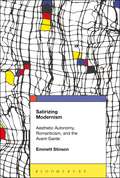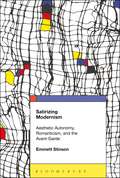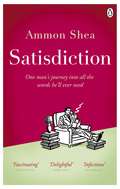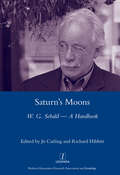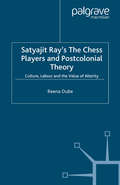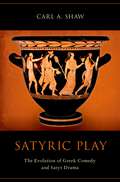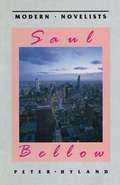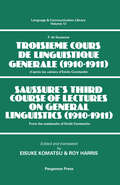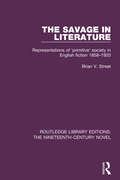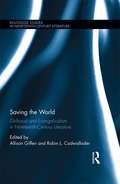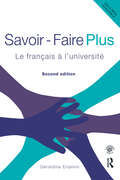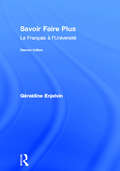- Table View
- List View
Satiric TV in the Americas: Critical Metatainment as Negotiated Dissent
by Paul AlonsoIn a time of global infotainment, the crisis of modern journalism, the omnipresence of celebrity culture and reality TV, and the colonization of public discourse by media spectacle and entertainment, postmodern satiric media have emerged as prominent critical voices playing an unprecedented role at the heart of public debate. Indeed, satiric media has filled gaps left not only by traditional media but also by weak social institutions and discredited political elites. In Satiric TV in the Americas, Paul Alonso analyzes the most influential satiric TV shows in the Americas--focusing on shows in Argentina, Peru, Ecuador, Mexico, Chile and the United States--in order to understand their critical role in challenging the status quo, traditional journalism, and the prevalent local media culture. Alonso illuminates the phenomenon of satire as resistance and negotiation in public discourse, the role of entertainment media as a site where socio-political tensions are played out, and the changing notions of journalism in today's democratic societies. Introducing the notion of "critical metatainment" -- a transgressive, self-referential reaction to the process of tabloidization and the cult of celebrity in the media spectacle era -- Satiric TV in the Americas is the first book to map, contextualize, and analyze relevant cases to understand the relation between political information, social and cultural dissent, critical humor, and entertainment in the region. Evaluating contemporary satiric media as a consequence of the collapse of modernity and its arbitrary dichotomies, Satiric TV in the Americas also shows that, as satiric formats travel to a particular national context, they are appropriated in different ways and adapted to local circumstances, with distinct consequences.
The Satirist: His Temperament, Motivation, And Influence
by Theodore DraperSatire takes as its subject the absurdity of human beings, their societies, and the institutions they create. For centuries, satirists themselves, scholars, critics, and psychologists have speculated about the satirist's reasons for writing, temperament, and place in society. The conclusions they have reached are sometimes contradictory, sometimes complementary, sometimes outlandish. In this volume, Leonard Feinberg brings together the major theories about the satirist, to provide in one book a summary of the problems that specialists have examined intensively in numerous books and articles.In part 1, Feinberg examines the major theories about the motivation of the satirist, and then proposes that "adjustment" comes most closely to answering this question. In his view, the satirist resolves his ambivalent relation to society through a playfully critical distortion of the familiar. The personality of the satirist, the apparently paradoxical elements of his nature, the problem of why so many great humorists are sad men, and the contributions of psychoanalysts are explored in part 2, where Feinberg contends that the satirist is not as abnormal as he has sometimes been made to seem, and that if he is a neurotic he shares traits of emotional or social alienation with many others. Part 3 explores the beliefs of satirists and their relation to the environment within which they function, particularly in the contexts of politics, religion, and philosophy. Feinberg stresses the ubiquity of the satirist and suggests that there are a great many people with satiric temperaments who fail to attain literary expression.Ranging with astonishing breadth, both historical and geographical, The Satirist serves as both an introduction to the subject and an essential volume for scholars. Brian A. Connery's introduction provides an overview of Feinberg's career and situates the volume in the intellectual currents in which it was written.
The Satirist
by Theodore DraperSatire takes as its subject the absurdity of human beings, their societies, and the institutions they create. For centuries, satirists themselves, scholars, critics, and psychologists have speculated about the satirist's reasons for writing, temperament, and place in society. The conclusions they have reached are sometimes contradictory, sometimes complementary, sometimes outlandish. In this volume, Leonard Feinberg brings together the major theories about the satirist, to provide in one book a summary of the problems that specialists have examined intensively in numerous books and articles.In part 1, Feinberg examines the major theories about the motivation of the satirist, and then proposes that "adjustment" comes most closely to answering this question. In his view, the satirist resolves his ambivalent relation to society through a playfully critical distortion of the familiar. The personality of the satirist, the apparently paradoxical elements of his nature, the problem of why so many great humorists are sad men, and the contributions of psychoanalysts are explored in part 2, where Feinberg contends that the satirist is not as abnormal as he has sometimes been made to seem, and that if he is a neurotic he shares traits of emotional or social alienation with many others. Part 3 explores the beliefs of satirists and their relation to the environment within which they function, particularly in the contexts of politics, religion, and philosophy. Feinberg stresses the ubiquity of the satirist and suggests that there are a great many people with satiric temperaments who fail to attain literary expression.Ranging with astonishing breadth, both historical and geographical, The Satirist serves as both an introduction to the subject and an essential volume for scholars. Brian A. Connery's introduction provides an overview of Feinberg's career and situates the volume in the intellectual currents in which it was written.
Satirizing Modernism: Aesthetic Autonomy, Romanticism, and the Avant-Garde
by Dr Emmett StinsonSatirizing Modernism examines 20th-century novels that satirize avant-garde artists and authors while also using experimental techniques associated with literary modernism. These novels-such as Wyndham Lewis's The Apes of God, William Gaddis's The Recognitions, and Gilbert Sorrentino's Imaginative Qualities of Actual Things-were under-recognized and received poor reviews at the time of publication, but have increasingly been acknowledged as both groundbreaking and deeply influential. Satirizing Modernism analyzes these novels in order to present an alternative account of literary modernism, which should be viewed neither as a radical break with the past nor an outmoded set of aesthetics overtaken by a later postmodernism. In self-reflexively critiquing their own aesthetics, these works express an unconventional modernism that both revises literary history and continues to be felt today.
Satirizing Modernism: Aesthetic Autonomy, Romanticism, and the Avant-Garde
by Emmett StinsonSatirizing Modernism examines 20th-century novels that satirize avant-garde artists and authors while also using experimental techniques associated with literary modernism. These novels-such as Wyndham Lewis's The Apes of God, William Gaddis's The Recognitions, and Gilbert Sorrentino's Imaginative Qualities of Actual Things-were under-recognized and received poor reviews at the time of publication, but have increasingly been acknowledged as both groundbreaking and deeply influential. Satirizing Modernism analyzes these novels in order to present an alternative account of literary modernism, which should be viewed neither as a radical break with the past nor an outmoded set of aesthetics overtaken by a later postmodernism. In self-reflexively critiquing their own aesthetics, these works express an unconventional modernism that both revises literary history and continues to be felt today.
Satisdiction: One Man's Journey Into All The Words He'll Ever Need
by Ammon SheaAmmon Shea was ten when he first discovered the joy of reading a dictionary rather than using it to look a word up. Little did he imagine that one day he would spend over $1,000 and sacrifice an entire bookcase and a whole year to the twenty volumes that make up the king of all reference books: The Oxford English Dictionary.It was a year that changed his life, not least when he fell in love with a lexicographer. In this hilarious, personal and fascinating book, with a chapter for each letter of the alphabet, Shea introduces us to hundreds of words he discovered that deserve to see the light of day again, and explains why. Want to know the word for the area on your back that you can't reach to scratch (acnestis)? Or the term for the smell of earth just after a rainstorm (petrichor)? Or perhaps you're just looking for the word to describe that feeling of saying enough (satisdiction). This book is all you need.
Saturn's Moons: A W.G Sebald Handbook
by Jo CatlingThe German novelist, poet and critic W. G. Sebald (1944-2001) has in recent years attracted a phenomenal international following for his evocative prose works such as Die Ausgewanderten (The Emigrants), Die Ringe des Saturn (The Rings of Saturn) and Austerlitz, spellbinding elegiac narratives which, through their deliberate blurring of genre boundaries and provocative use of photography, explore questions of Heimat and exile, memory and loss, history and natural history, art and nature. Saturn's Moons: a W. G. Sebald Handbook brings together in one volume a wealth of new critical and visual material on Sebald's life and works, covering the many facets and phases of his literary and academic careers -- as teacher, as scholar and critic, as colleague and as collaborator on translation. Lavishly illustrated, the Handbook also contains a number of rediscovered short pieces by W. G. Sebald, hitherto unpublished interviews, a catalogue of his library, and selected poems and tributes, as well as extensive primary and secondary bibliographies, details of audiovisual material and interviews, and a chronology of life and works. Drawing on a range of original sources from Sebald's Nachlass - the most important part of which is now held in the Deutsches Literaturarchiv Marbach - Saturn's Moons6g will be an invaluable sourcebook for future Sebald studies in English and German alike, complementing and augmenting recent critical works on subjects such as history, memory, modernity, reader response and the visual. The contributors include Mark Anderson, Anthea Bell, Ulrich von Buelow, Jo Catling, Michael Hulse, Florian Radvan, Uwe Schuette, Clive Scott, Richard Sheppard, Gordon Turner, Stephen Watts and Luke Williams. Jo Catling teaches in the School of Literature at the University of East Anglia and Richard Hibbitt in the Department of French at the University of Leeds.
Saturn's Moons: A W.G Sebald Handbook
by Jo CatlingThe German novelist, poet and critic W. G. Sebald (1944-2001) has in recent years attracted a phenomenal international following for his evocative prose works such as Die Ausgewanderten (The Emigrants), Die Ringe des Saturn (The Rings of Saturn) and Austerlitz, spellbinding elegiac narratives which, through their deliberate blurring of genre boundaries and provocative use of photography, explore questions of Heimat and exile, memory and loss, history and natural history, art and nature. Saturn's Moons: a W. G. Sebald Handbook brings together in one volume a wealth of new critical and visual material on Sebald's life and works, covering the many facets and phases of his literary and academic careers -- as teacher, as scholar and critic, as colleague and as collaborator on translation. Lavishly illustrated, the Handbook also contains a number of rediscovered short pieces by W. G. Sebald, hitherto unpublished interviews, a catalogue of his library, and selected poems and tributes, as well as extensive primary and secondary bibliographies, details of audiovisual material and interviews, and a chronology of life and works. Drawing on a range of original sources from Sebald's Nachlass - the most important part of which is now held in the Deutsches Literaturarchiv Marbach - Saturn's Moons6g will be an invaluable sourcebook for future Sebald studies in English and German alike, complementing and augmenting recent critical works on subjects such as history, memory, modernity, reader response and the visual. The contributors include Mark Anderson, Anthea Bell, Ulrich von Buelow, Jo Catling, Michael Hulse, Florian Radvan, Uwe Schuette, Clive Scott, Richard Sheppard, Gordon Turner, Stephen Watts and Luke Williams. Jo Catling teaches in the School of Literature at the University of East Anglia and Richard Hibbitt in the Department of French at the University of Leeds.
Satyajit Ray's The Chess Players and Postcolonial Film Theory: Postcolonialism and Film Theory (Language, Discourse, Society)
by Reena DubeIndispensable for students of film studies, in this book Reena Dube explores Satyajit Ray's films, and The Chess Players in particular, in the context of discourses of labour in colonial and postcolonial conditions. Starting from Daniel Defoe and moving through history, short story and film to the present, Dube widens her analysis with comparisons in which Indian films are situated alongside Hollywood and other films, and interweaves historical and cultural debates within film theory. Her book treats film as part of the larger cultural production of India and provides a historical sense of the cross genre borrowings, traditions and debates that have deeply influenced Indian cinema and its viewers.
Satyric Play: The Evolution of Greek Comedy and Satyr Drama
by Carl ShawSatyric Play is the first book to offer an integrated analysis of Greek comedy and satyr drama. Using a literary-historical approach, Carl A. Shaw argues that comedy and satyr plays influenced each other in nearly all stages of their development. Although satyr drama was written by tragedians and employed a number of formal tragic elements, the humorous chorus of half-man, half-horse satyrs encouraged sustained interaction between poets of comedy and satyr play. From sixth-century proto-drama, through classical productions staged at the Athenian City Dionysia, to bookish Alexandrian plays of the third-century, the remains of comic and satyric performances reveal a range of literary, aesthetic, historical, religious, and geographical connections. Shaw analyzes the details of this interplay diachronically, looking at a wide range of literary and material evidence. He shows that ancient critics and poets allude to comic-satyric associations in surprising ways, vases depict fascinating performative connections, and the plays themselves share titles, plots, modes of humor, and occasionally even a chorus of satyrs. Satyric Play uncovers and examines the complex, shifting relationship between comedy and satyr drama, offering insight into the development of these genres and the Greek theatrical experience as a whole.
The Satyricon: the Apocolocyntosis (Penguin Classics Series)
by Petronius SenecaPerhaps the strangest - and most strikingly modern - work to survive from the ancient world, The Satyricon relates the hilarious mock epic adventures of the impotent Encolpius, and his struggle to regain virility. Here Petronius brilliantly brings to life the courtesans, legacy-hunters, pompous professors and dissolute priestesses of the age - and, above all, Trimalchio, the archetypal self-made millionaire whose pretentious vulgarity on an insanely grand scale makes him one of the great comic characters in literature. Seneca's The Apocolocyntosis, a malicious skit on 'the deification of Claudius the Clod', was designed by the author to ingratiate himself with Nero, who was Claudius' successor. Together, the two provide a powerful insight into a darkly fascinating period of Roman history.
Saul Bellow (Modern Novelists)
by Peter Myland Lan Anh HoangPeter Hyland's study provides a clear and comprehensive introduction to Bellow's fiction. He gives a brief survey of the novelists's life and career, followed by a chronological account of all of his novels; in a separate chapter he considers the most significant of Bellow's short stories. The reader will find here a stimulating guide to Bellow's work and its place in the development of modern literature and ideas.
Saul Bellow and the Decline in Humanism (New Directions in American Studies)
by Michael K. GlendayThis is a study revealing Saul Bellow's views on the decline of humanism. With chapters on each of Bellow's novels from "Dangling" to "More Die of Heartbreak", the author argues that Bellow's vision of modern American culture denies the possibility of humanist enlightenment for his heroes.
Saussure: A Guide For The Perplexed (Guides for the Perplexed)
by Paul BouissacFerdinand de Saussure (1857-1913) is generally considered one of the main founders of modern linguistics and semiotics. The book that was derived from his teaching, the Course in General Linguistics, had a lasting impact on the intellectual life of the 20th century and remains today an object of debates and controversies. This Guide for the Perplexed introduces the reader to the ways in which Saussure developed his revolutionary insights on language in the context of the linguistics of his time. It also provides clear definitions and explanations of the basic notions that form the substance of his work, with relevant examples of how they apply to the understanding of language and other symbolic systems. The book demonstrates how Saussure's ideas have subsequently been used in the humanities and social sciences. It concludes by pointing to the continuing relevance of the theoretical and practical problems that were articulated by Saussure. This is the ideal book for those studying Saussure, structural linguistics or semantics and semiotics, offering a clear overview and explanation of all the key aspects of this fascinating linguist's work.
Saussure: A Guide For The Perplexed (Guides for the Perplexed #203)
by Paul BouissacFerdinand de Saussure (1857-1913) is generally considered one of the main founders of modern linguistics and semiotics. The book that was derived from his teaching, the Course in General Linguistics, had a lasting impact on the intellectual life of the 20th century and remains today an object of debates and controversies. This Guide for the Perplexed introduces the reader to the ways in which Saussure developed his revolutionary insights on language in the context of the linguistics of his time. It also provides clear definitions and explanations of the basic notions that form the substance of his work, with relevant examples of how they apply to the understanding of language and other symbolic systems. The book demonstrates how Saussure's ideas have subsequently been used in the humanities and social sciences. It concludes by pointing to the continuing relevance of the theoretical and practical problems that were articulated by Saussure. This is the ideal book for those studying Saussure, structural linguistics or semantics and semiotics, offering a clear overview and explanation of all the key aspects of this fascinating linguist's work.
Saussure’s Linguistics, Structuralism, and Phenomenology: The Course in General Linguistics after a Century
by Beata StawarskaThis is the first English-language guidebook geared at an interdisciplinary audience that reflects relevant scholarly developments related to the legacy and legitimacy of Ferdinand de Saussure's Course in General Linguistics (1916) today. It critically assesses the relation between materials from the Course and from the linguist’s Nachlass (works unpublished or even unknown at Saussure’s death, some of them recently discovered). This book pays close attention to the set of oppositional pairings: the signifier and the signified, la langue (language system) and la parole (speech), and synchrony and diachrony, that became the hallmark of structuralism across the humanities. Sometimes referred to as the “Saussurean doctrine,” this hierarchical conceptual apparatus becomes revised in favor of a horizontal set of relations, which co-involves speaking subjects and linguistic structures. This book documents the continued relevance of Saussure’s linguistics in the 21st Century, and it sheds light on its legacy within structuralism and phenomenology. The reader can consult the book on its own, or in tandem with the 1916 Course.
Saussure's Third Course of Lectures on General Linguistics: (F. de Saussure - Troisième Cours de Linguistique Générale (1910-1911) (Language and Communication Library)
by R. Harris E. KomatsuThe notes taken by Saussure's student Emile Constantin were not available to the editors of the published Cours de linguistique générale (1916), and came to light only after the second world war. They have never been published in their entirety.The third and last course of lectures, of which Constantin kept this very full record, is generally considered to represent a more advanced version of Saussure's teaching than the earlier two. It is clear that Constantin's notebooks offer a text which differs in a number of significant respects from the Cours published by Saussure's original editors, and bring forward ideas which do not emerge in the 1916 publication. They constitute unique evidence concerning the final stages of Saussure's thinking about language.This edition of the notes is accompanied by an introduction and a full English translation of the text. There has been no attempt made by Komatsu and Harris, to turn the English into readable prose. Constantin's notes, even as revised by their author, retain the infelicities, repetitions, abruptness - occasionally incoherences - that betray the circumstances of their origin.The volume constitutes an important landmark in the history of modern linguistics and provides essential documentation for all scholars and libraries specializing in the subject.
Savage Horrors: The Intrinsic Raciality of the American Gothic (American Culture Studies #29)
by Corinna LenhardtThe American Gothic novel has been deeply shaped by issues of race and raciality from its origins in British Romanticism to the American Gothic novel in the twenty-first century. Savage Horrors delineates an intrinsic raciality that is discursively sedimented in the Gothic's uniquely binary structure. Corinna Lenhardt uncovers the destructive and lasting impact of the Gothic's anti-Black racism on the cultural discourses in the United States. At the same time, Savage Horrors traces the unflinching Black resistance back to the Gothic's intrinsic raciality. The African American Gothic, however, does not originate there but in the Black Atlantic - roughly a decade before the first Gothic novel was ever written on American soil.
The Savage in Literature: Representations of 'primitive' society in English fiction 1858-1920 (Routledge Library Editions: The Nineteenth-Century Novel)
by Brian V. StreetFirst published in 1975, this study is concerned with the representation of non-European people in English popular fiction in the period from 1858-1920. It examines the developments in thinking about people across the world and shows how they affected writers’ views of evolution, race, heredity and of the life of the so-called ‘primitive’ man. This book will be of interest to those studying 19th century literature.
The Savage in Literature: Representations of 'primitive' society in English fiction 1858-1920 (Routledge Library Editions: The Nineteenth-Century Novel)
by Brian V. StreetFirst published in 1975, this study is concerned with the representation of non-European people in English popular fiction in the period from 1858-1920. It examines the developments in thinking about people across the world and shows how they affected writers’ views of evolution, race, heredity and of the life of the so-called ‘primitive’ man. This book will be of interest to those studying 19th century literature.
Saving the World: Girlhood and Evangelicalism in Nineteenth-Century Literature (Routledge Studies in Nineteenth Century Literature #1)
by Allison Giffen Robin L. CadwalladerThis book makes a significant contribution to the burgeoning field of childhood studies in nineteenth-century literature and culture by drawing on the intersecting fields of girlhood, evangelicalism, and reform to investigate texts written in North America about girls, for girls, and by girls. Responding both to the intellectual excitement generated by the rise of girlhood studies, as well as to the call by recent scholars to recognize the significance of religion as a meaningful category in the study of nineteenth-century literature and culture, this collection locates evangelicalism at the center of its inquiry into girlhood. Contributors draw on a wide range of texts, including canonical literature by Harriet Beecher Stowe, Susan Warner, and Elizabeth Stuart Phelps, and overlooked archives such as US Methodist Sunday School fiction, children’s missionary periodicals, and the Christian Recorder, the flagship newspaper of the African Methodist Episcopal (AME) Church. These essays investigate representations of girlhood that engage, codify, and critique normative Protestant constructions of girlhood. Contributors examine girlhood in the context of reform, revealing the ways in which Protestantism at once constrained and enabled female agency. Drawing on a range of critical perspectives, including African American Studies, Disability Studies, Gender Studies, and Material Culture Studies, this volume enriches our understanding of nineteenth-century childhood by focusing on the particularities of girlhood, expanding it beyond that of the white able-bodied middle-class girl and attending to the intersectionality of identity and religion.
Saving the World: Girlhood and Evangelicalism in Nineteenth-Century Literature (Routledge Studies in Nineteenth Century Literature #1)
by Allison Giffen Robin L. CadwalladerThis book makes a significant contribution to the burgeoning field of childhood studies in nineteenth-century literature and culture by drawing on the intersecting fields of girlhood, evangelicalism, and reform to investigate texts written in North America about girls, for girls, and by girls. Responding both to the intellectual excitement generated by the rise of girlhood studies, as well as to the call by recent scholars to recognize the significance of religion as a meaningful category in the study of nineteenth-century literature and culture, this collection locates evangelicalism at the center of its inquiry into girlhood. Contributors draw on a wide range of texts, including canonical literature by Harriet Beecher Stowe, Susan Warner, and Elizabeth Stuart Phelps, and overlooked archives such as US Methodist Sunday School fiction, children’s missionary periodicals, and the Christian Recorder, the flagship newspaper of the African Methodist Episcopal (AME) Church. These essays investigate representations of girlhood that engage, codify, and critique normative Protestant constructions of girlhood. Contributors examine girlhood in the context of reform, revealing the ways in which Protestantism at once constrained and enabled female agency. Drawing on a range of critical perspectives, including African American Studies, Disability Studies, Gender Studies, and Material Culture Studies, this volume enriches our understanding of nineteenth-century childhood by focusing on the particularities of girlhood, expanding it beyond that of the white able-bodied middle-class girl and attending to the intersectionality of identity and religion.
Savoir Faire Plus: Le Français à l’Université
by Géraldine EnjelvinWritten by an experienced tutor, Savoir-Faire Plus is specifically designed to meet the requirements of today’s generation of language undergraduates. Focusing on the life of an Anglophone first year undergraduate studying French in the UK and sharing a house with four francophone students, this engaging textbook provides: a clear, logical structure a blend of communicative, research-based and traditional exercises a wide range of activities covering the four key linguistic skills as well as intercultural skills authentic texts (with extracts from Le Monde, L’Express, Le Nouvel Observateur and Libération) guidance and practical tips for effective and independent learning. Each of the ten chapters consists of four topics-based sections which provide students with a wealth of diverse material allowing them to gain an in-depth knowledge of relevant topical subjects such as regional languages, sustainable development and fair trade, amongst others. Digestible grammar points are integrated throughout and a range of additional exercises are available on the Companion Website allowing students to perfect their language skills. Suitable for both self-study and class use Savoir Faire Plus is the ideal course for all advanced students of French, consolidating knowledge gained at A-Level while supporting the transition to undergraduate study. The Companion Website can be found at www.routledge.com/textbooks/9780415444750
Savoir Faire Plus: Le Français à l’Université
by Géraldine EnjelvinWritten by an experienced tutor, Savoir-Faire Plus is specifically designed to meet the requirements of today’s generation of language undergraduates. Focusing on the life of an Anglophone first year undergraduate studying French in the UK and sharing a house with four francophone students, this engaging textbook provides: a clear, logical structure a blend of communicative, research-based and traditional exercises a wide range of activities covering the four key linguistic skills as well as intercultural skills authentic texts (with extracts from Le Monde, L’Express, Le Nouvel Observateur and Libération) guidance and practical tips for effective and independent learning. Each of the ten chapters consists of four topics-based sections which provide students with a wealth of diverse material allowing them to gain an in-depth knowledge of relevant topical subjects such as regional languages, sustainable development and fair trade, amongst others. Digestible grammar points are integrated throughout and a range of additional exercises are available on the Companion Website allowing students to perfect their language skills. Suitable for both self-study and class use Savoir Faire Plus is the ideal course for all advanced students of French, consolidating knowledge gained at A-Level while supporting the transition to undergraduate study. The Companion Website can be found at www.routledge.com/textbooks/9780415444750


